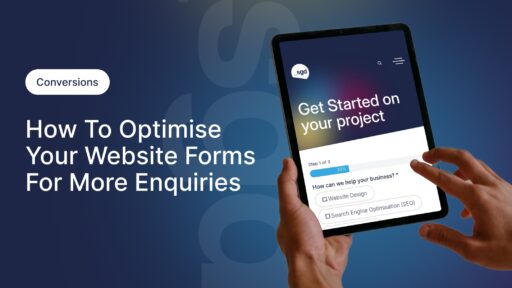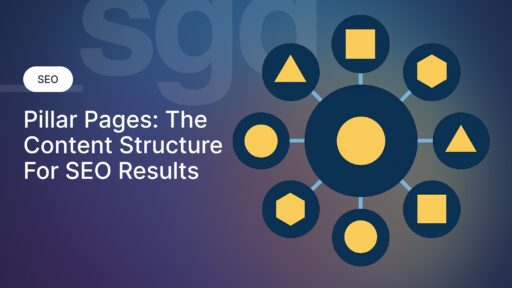Website Wireframing: How Smart Web Page Structure Drives Business Results
May 12, 2025 — Simon Kelly

A beautiful website design isn’t enough if your pages don’t guide people, tell a clear story, and drive action.
Before you even start on colours, fonts, or layouts, the real value happens in the planning, in your wireframes, your storytelling, and your page structure.
For your business to stay competitive, your website design should go beyond making a website that just looks good – it should be designed to connect, guide, and convert.
In this guide, we’ll walk you through how smart wireframing, strong storytelling, and conversion-focused page structures can transform your site from “nice-looking” to “high-performing.”
How Wireframing Sets Your Website Up for Success
A wireframe is a simple visual outline of your page— think of it like an architect’s sketch before building a house.
It maps out what goes where: headlines, text blocks, images, buttons— all without the distraction of colours, graphics, or fancy design.
Wireframing helps you:
- Focus on functionality first, not decoration.
- Build a logical flow that matches how users actually think and browse.
- Spot gaps, clutter, or dead ends before you waste time on design or development.
A good wireframe ensures that your page has purpose, clarity, and momentum— essential ingredients for higher engagement and more conversions.
Storytelling: How Your Website Should “Speak” To Your Visitors
Every page on your site tells a story, whether you plan your website carefully or let it happen by accident.
Smart storytelling is about connecting with your audience emotionally, then guiding them rationally to take action.
Great website storytelling often follows a simple flow:
- Problem/Desire: Identify what your visitor cares about.
- Solution/Value: Show how you solve it or meet that need.
- Proof/Trust: Build credibility (social proof, stats, testimonials).
- Action: Make the next step clear and easy.
Whether you’re selling a product, offering a service, or inviting contact, your pages should always answer:
- Why should I care?
- Why should I trust you?
- What should I do next?
Why Structure and Scannability Make or Break Your Website
Today’s users don’t read websites, they scan them.
Good page structure helps your website visitors to:
- Instantly understand what your page is about
- Navigate easily without frustration
- Find the information they care about without hunting
- Know how to start doing business with you
If users can’t instantly understand what your page is about, they’ll leave.
That’s why making your pages easy to scan is one of the most important parts of good website structure.
Here’s how to create a page that draws readers in, not drives them away:
Use clear headings and subheadings: Organise your content with a logical H1 → H2 → H3 structure. Your headings should tell a clear story even without reading the full text.
Keep paragraphs short and punchy: Aim for 2-4 lines per paragraph. Shorter blocks of text are easier to digest, especially on mobile devices.
Break information into bullet points or numbered lists: Lists are easier for the eye to catch, helping readers quickly absorb key points (like you’re doing right now).
Give your content breathing room with ample white space: White space isn’t wasted space. It makes your content feel calmer, more polished, and less overwhelming to navigate.
Place calls to action (CTAs) consistently and naturally: Buttons, links, and forms shouldn’t feel hidden or jammed in at random.
Weave CTAs naturally into the flow so that readers always have a clear next step— whether it’s to learn more, get in touch, or make a purchase.
If someone can’t grasp your message within a 5-second scan, you’re likely losing them.
Structuring for Conversions: The Blueprint for Action
A website that looks good but doesn’t convert is like a shop window no one walks into.
Structuring your pages for conversions means:
Leading with value: Hook your reader within the first headline and paragraph.
Stacking your content logically: Intro → Benefits → Proof → CTA.
Repeating calls to action: Don’t rely on just one button at the bottom— sprinkle CTAs naturally throughout.
Reducing friction: Make forms short, checkout processes simple, and next steps obvious.
Building trust along the way: Include testimonials, certifications, client logos, and guarantees.
The goal? Every scroll, every click, and every word should gently move your visitor toward taking the next step, without feeling forced.
Wireframing and Structuring Best Practices
Here’s how we approach high-performing page structure at SGD:
- Start with a rough wireframe: Focus only on layout and flow first.
- Map the story: What problem are you solving? How does the page build trust and momentum?
- Structure for scanning: Break up text, use strong headings, and lead with benefits.
- Make CTAs clear and easy: Every major section should invite action (without being pushy).
- Test and refine: Before you build out the full design, get feedback— is the flow logical? Is the story compelling?
Easy-to-Miss Website Mistakes
Even well-designed websites can fall short if you miss a few critical details.
Here are some common pitfalls to watch out for— and why they matter more than you might think:
1. Overloading your pages with walls of text
If your content looks dense and overwhelming, most users won’t even start reading— they’ll leave.
Break up your text with headings, bullet points, short paragraphs, and white space to keep visitors engaged.
2. Burying key information too deep
If people have to scroll endlessly or dig through multiple pages to find what they’re looking for, you’re losing them.
Surface your most important messages, benefits, and CTAs early and often.
3. Forgetting about mobile users
With over half of all web traffic coming from mobile devices, your site structure needs to work just as beautifully on a small screen.
Menus, CTAs, forms, and layouts should all be designed mobile-first, not as an afterthought.
4. Neglecting emotional connection
Facts and features aren’t enough.
Visitors act when they feel something— whether it’s trust, excitement, relief, or a sense of belonging.
Great websites tap into emotions first and use logic to back them up. Ensure your story resonates with real human needs, not just technical specifications.
Avoiding these common mistakes doesn’t just improve how your website looks— it dramatically boosts how well it connects, engages, and converts.
Ready to Build Pages That Connect and Convert?
At SGD, we don’t believe in guesswork – we leverage proven web page frameworks and tailor them to suit your business.
We design websites and landing pages with clear wireframes, smart storytelling, and conversion-driven structures from the very first sketch, so you’re not just launching a site – you’re launching a marketing tool that supports growth.
Need help wireframing, structuring, and designing a website that actually works?
Let’s start with a conversation.
Author

Simon Kelly
Simon Kelly is the CEO and Head of Growth at SGD. Simon started his first web agency in 2009 which he merged with the SGD team in 2023. With a strong background in digital strategy and a history of working with fast-growing Australian companies, including CyberCX, Envato and Agency Mavericks, he's passionate about using ethical digital marketing that delivers business value. Simon's experience includes coaching digital agencies, running digital marketing workshops, driving growth and excellence within the SGD team.
Unlock Weekly Insights To Improve Your Website
Want to improve your website and digital marketing? Sign up to Marketing Monday for practical, up-to-date strategies on SEO, Google Ads, and website performance—delivered weekly.
No fluff, just results-driven advice. Unsubscribe anytime.
Next Article
The Smarter Website Sitemap
May 1, 2025Start a Project








